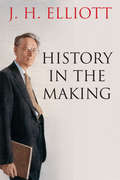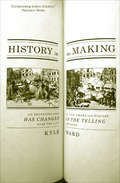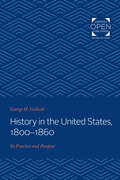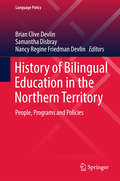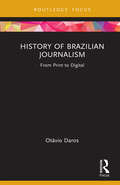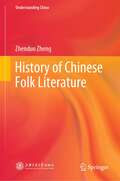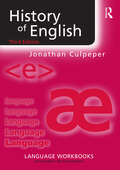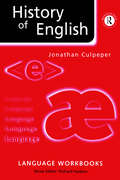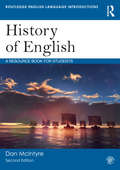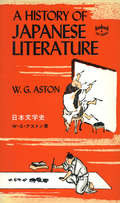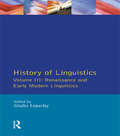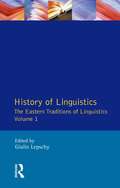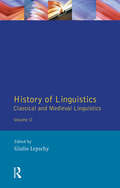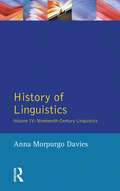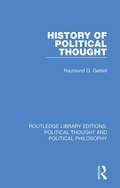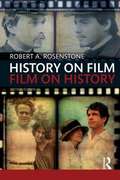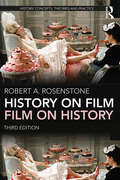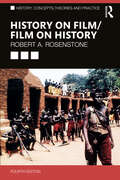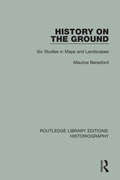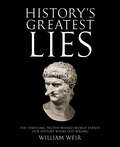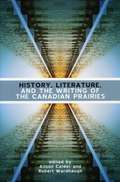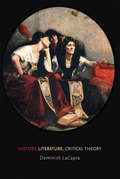- Table View
- List View
History in the Making
by J. H. ElliottFrom the vantage point of nearly sixty years devoted to research and the writing of history, J. H. Elliott steps back from his work to consider the progress of historical scholarship. From his own experiences as a historian of Spain, Europe, and the Americas, he provides a deft and sharp analysis of the work that historians do and how the field has changed since the 1950s. The author begins by explaining the roots of his interest in Spain and its past, then analyzes the challenges of writing the history of a country other than one's own. In succeeding chapters he offers acute observations on such topics as the history of national and imperial decline, political history, biography, and art and cultural history. Elliott concludes with an assessment of changes in the approach to history over the past half-century, including the impact of digital technology, and argues that a comprehensive vision of the past remains essential. Professional historians, students of history, and those who read history for pleasure will find in Elliott's delightful book a new appreciation of what goes into the shaping of historical works and how those works in turn can shape the world of thought and action.
History in the Making: An Absorbing Look at How American History Has Changed in the Telling over the Last 200 Years
by Kyle WardThe popular, &“thought-provoking study&” that explores how contemporary prejudices change the way each generation looks at the nation&’s past (Library Journal). Historian Kyle Ward, the acclaimed co-author of History Lessons, offers another fascinating look at the biases inherent in the way we think about, write about, and teach our own history. Juxtaposing passages from US history textbooks of different eras, History in the Making provides new perspectives on familiar historical events, and sheds light on the ways they have been represented over generations. Covering subjects that span two hundred years, from Columbus&’s arrival to the Boston Massacre, from women&’s suffrage to Japanese internment, History in the Making exposes the changing values, priorities, and points of view that have framed—and reframed—our past. &“Interesting and useful . . . convincingly illustrates how texts change as social and political attitudes evolve.&” —Booklist &“Students, teachers, and general readers will learn more about the past from these passages than from any single work, however current, that purports to monopolize the truth.&” —Ray Raphael, author of Founding Myths
History in the Making: The Story of the American Printing House for the Blind 1858-2008
by Carol Brenner TobeThis beautifully illustrated 150th Anniversary book celebrates the history of the American Printing House for the Blind (which is based in Louisville, Kentucky) and examines its mission to provide specialized materials, books, products, and services to the visually impaired. Author Carol Tobe guides the reader through all of the Printing House's mechanical innovations and evolutions right up to today's digital solutions. Hundreds of color photographs showcase the Printing House, its people, and machines of the past and present. Its story is virtually the story of blind people in America.
History in the United States, 1800-1860: Its Practice and Purpose
by George H. CallcottOriginally published in 1970. Professor Callcott's analysis of the rise of historical consciousness in the United States from 1800 to 1860 offers a new dimension to American historiography. Other books have provided insight into the works of Bancroft, Parkman, and others, but Callcott goes beyond to explain the meaning of the past itself rather than the contributions of particular historians. As the anatomy of an idea, this is an important contribution to American intellectual history; and as a study of humans' need for the past and their use of it, it is an important contribution to American social history. The author begins by analyzing the European and Romantic background for American historical thought. He then explores the rise of historical themes in literature, education, the arts, and scholarship. By describing the type of historical subject matter, the methods of writing history, the interpretive themes historians used, and the standards by which critics judged history, Callcott offers a new understanding of the social and personal meaning that history had for Americans at the time. The American people were especially convinced of the utility of history—its social use in supporting accepted values, its personal utility in extending human experience, and its philosophical value in pointing people toward ultimate reality. The idea of history possessed a remarkable coherence that reflected the preoccupations and aspirations of the young nation. Callcott also demonstrates, however, that when basic historical assumptions were challenged by controversy, the entire edifice collapsed.
History of Bilingual Education in the Northern Territory
by Brian Clive Devlin Samantha Disbray Nancy Regine Friedman DevlinThis book provides the first detailed history of the Bilingual Education Program in the Northern Territory of Australia. This ambitious and innovative program began in 1973 and at different times it operated in English and 19 Aboriginal languages in 29 very remote schools. The book draws together the grassroots perspectives of Indigenous and non-Indigenous practitioners and researchers. Each chapter is based on rich practitioner experience, capturing bottom-up aspirations, achievements and reflections on this innovative, yet largely undocumented language and education program. The volume also makes use of a significant collection of 'grey literature' documents to trace the history of the program. An ethnographic approach has been used to integrate practitioner accounts into the contexts of broader social and political forces, education policy decisions and on-the-ground actions. Language in education policy is viewed at multiple, intersecting levels: from the interactions of individuals, communities of practice and bureaucracy, to national and global forces. The book offers valuable insights as it examines in detail the policy settings that helped and hindered bilingual education in the context of minority language rights in Australia and elsewhere.
History of Brazilian Journalism: From Print to Digital (Routledge Focus on Communication and Society)
by Otávio DarosThis book constitutes a first-of-its-kind synthesis of the development of journalism in Brazil, considering both its mediations with national social and political life and its relationships of influence and dependence on international economic centers. The author suggests that Brazilian journalism has so far known four phases: doctrinal political journalism, narrative literary journalism, industrial news journalism, and multimedia infotainment journalism. Devoting a chapter to each phase, Daros presents a critical map of the genesis and metamorphosis of journalistic practices in the country. The analysis goes beyond a mere study of national history to mark the points of connection between the Brazilian case and other geographic spaces, showing how the profession moved between two Western paradigms and was continually shaped by the economic, political, and cultural context from which it emerged and was inserted. The final part of the book reflects critically on the state of Brazilian journalism today, considering the new social media culture, the increasing focus on costs over quality of news products, and the failed social responsibility of the profession to inform national public opinion. This study is an important touchstone for researchers of Brazilian and Latin American journalism and those interested in the ways in which the media shapes and is shaped by a country’s socio-political climate.
History of Chinese Folk Literature (Understanding China)
by Zhenduo ZhengThis book mainly addresses the position, function, influence, and values of folk oral literature in the history of Chinese literature. Divided into 14 chapters, it systematically covers central aspects of folklore literature such as ballads, folk songs, Bianwen, Zajuci, Guzici, Zhugongdiao, Sanqu, Baojuan, Tanci, Zidishu, and so on from the Pre-Qin to the late Qing Dynasties, filling several gaps in literary history studies. It is a comprehensive literary work, and many of the materials cited here are rare and difficult to find. In addition, the book proposes some important theories, especially six highly generalized qualities of folk literature, namely that it is: popular, collective, oral, fresh, effusive, and innovative.With detailed, extensive materials, and quotations, the book represents the most systematic and comprehensive work to date on ancient Chinese folk literature. It is mutually complementary with Guowei Wang’s A Textual Research of the Traditional Chinese Opera in the Song and Yuan Dynasties and Xun Lu’s A Brief History of Chinese Fiction; all three works are regarded as the most essential classics for researching the history of Chinese literature.
History of English (Language Workbooks)
by Jonathan CulpeperRoutledge Language Workbooks provide absolute beginners with practical introductions to core areas of language study. Books in the series provide comprehensive coverage of the area as well as a basis for further investigation. Each Language Workbook guides the reader through the subject using ‘hands-on’ language analysis, equipping them with the basic analytical skills needed to handle a wide range of data. Written in a clear and simple style, with all technical concepts fully explained, Language Workbooks can be used for independent study or as part of a taught class. History of English: • examines the history of the English language in order to explain the English that is used today • introduces key linguistic concepts • provides ‘discussion points’ to generate debate • encourages readers to think critically about the subject • involves readers in collecting and analysing their own data • contains a ‘mini-corpus’ of texts, used for exercises and to illustrate points raised in the commentary Revised throughout, this updated edition integrates the latest research on the history of English, including an additional chapter on English letters and punctuation, and an updated bibliography. History of English, 3rd edition provides an essential introduction and workbook for students coming to this subject for the first time.
History of English (Language Workbooks)
by Jonathan CulpeperHistory of English: * covers the development of the English language from the 5th century to the present day* contains a `mini-corpus' of texts, used for exercises and to illustrate points raised in the commentary* introduces key linguistic concepts* provides `discussion points' to generate debate* involves readers in collecting and analysing their own data
History of English: A Resource Book for Students (Routledge English Language Introductions)
by Dan McIntyreRoutledge English Language Introductions cover core areas of language study and are one-stop resources for students. Assuming no prior knowledge, books in the series offer an accessible overview of the subject, with activities, study questions, sample analyses, commentaries and key readings – all in the same volume. The innovative and flexible ‘two-dimensional’ structure is built around four sections – introduction, development, exploration and extension – which offer self-contained stages for study. Each topic can also be read across these sections, enabling the reader to build gradually on the knowledge gained. This revised second edition of History of English includes: ❑ a comprehensive introduction to the history of English covering the origins of English, the change from Old to Middle English, and the influence of other languages on English; ❑ increased coverage of key issues, such as the standardisation of English; ❑ a wider range of activities, plus answers to exercises; ❑ new readings of well-known authors such as Manfred Krug, Colette Moore, Merja Stenroos and David Crystal; ❑ a timeline of important external events in the history of English. Structured to reflect the chronological development of the English language, History of English describes and explains the changes in the language over a span of 1,500 years, covering all aspects from phonology and grammar, to register and discourse. In doing so, it incorporates examples from a wide variety of texts and provides an interactive and structured textbook that will be essential reading for all students of English language and linguistics.
History of Japanese Literature
by William George AstonProfessor Aston's A History of Japanese Literature has a permanent place on the bookshelves of all lovers of Japan. William George Aston, who pioneered in the translation of Japanese literature into English, made many original contributions to Japanese studies. His writing is fresh and informative.The periods reviewed range from the ancient days, when Japan's history was just dawning, to the Meiji Restoration of 1868, when all aspects of Japanese life were being transformed. No aspect of Japanese culture escaped modification or change after Meiji, but Aston is mainly concerned with the profound literary heritage of Japan before Westernization.A long-time resident of Japan, who was intimately acquainted with Japanese books and scholars, he used the unique opportunities of his life to make available to English Readers the new world of Japanese literature. His scholarship is vast, yet he never loses the human touch, and he is always easy to read.
History of Linguistics Vol III: Renaissance and Early Modern Linguistics (Longman Linguistics Library)
by Giulio C. LepschyTheHistory of Linguistics, to be published in five volumes, aims to provide the reader with an authoritative and comprehensive account of the attitudes to language prevailing in different civilizations and in different periods by examining the very varied development of linguistic thought in the specific social, cultural and religious contexts involved. Issues discussed include the place of language in education, variation and prestige, and approaches to lexical and grammatical description. The authors of the individual chapters are specialists who have analysed the primary sources and produced original syntheses by exploring the linguistic interests and assumptions of particular cultures in their own terms, without seeking to reinterpret them as contributions towards the development of contemporary western conceptions of linguistic science.The third volume of the History of Linguistics covers the Renaissance and the Early Modern Period. The chapter on the Renaissance (15th and 16th centuries), examines the study of Latin in both the new Humanist and rationalist traditions, along with the foundations of vernacular grammar in the study of Romance, Germanic and Slavic. The chapter on the Early Modern Period (17th and 18th centuries) presents the study of language in its philosophical context (Bacon, Port-Royal, Hobbes, Locke, Leibniz, the Enlightenment), as well as the accumulation of data which led to the foundation of Comparative Philology in the 19th century.
History of Linguistics Volume I: The Eastern Traditions of Linguistics (Longman Linguistics Library)
by Giulio LepschyThis comprehensive history of linguistics is part of a 5 volume set. Together, the volumes examine the social, cultural and religious functions of language, its place in education, the prestige attached to different varieties of language, and the presentation of lexical and grammatical descriptions. They explore the linguistic interests and assumptions of individual cultures in their own terms, without trying to transpose and reshape them into the context of contemporary ideas of what the scientific study of language ought to be. The authors of individual chapters are all specialists who have been able to analyse the primary sources, and so produce original syntheses which offer an authoritative view of the different traditions and periods. Volime One examines the developments of Chinese linguistics, Indian grammatical tradition, the linguistic interests of the Near East, the Hebrew tradition, and the Arabic grammatical system of the Middle Ages.
History of Linguistics Volume II: Classical and Medieval Linguistics (Longman Linguistics Library)
by Giulio C. LepschyThis comprehensive history of linguistics is part of a 5 volume set. Together, the volumes examine the social, cultural and religious functions of language, its place in education, the prestige attached to different varieties of language, and the presentation of lexical and grammatical descriptions. They explore the linguistic interests and assumptions of individual cultures in their own terms, without trying to transpose and reshape them into the context of contemporary ideas of what the scientific study of language ought to be. The authors of individual chapters are all specialists who have been able to analyse the primary sources, and so produce original syntheses which offer an authoritative view of the different traditions and periods. Volume Two examines the Greek, Roman and Medieval European traditions, which between them developed the grammatical and syntactical models which form the basis of our inherited linguistic assumptions.
History of Linguistics, Volume IV: Nineteenth-Century Linguistics (Longman Linguistics Library)
by Anna Morpurgo Davies Giulio C. LepschyThe History of Linguistics, to be published in five volumes, aims to provide the reader with an authoritative and comprehensive account of the attitudes to language prevailing in different civilizations and in different periods by examining the very varied development of linguistic thought in the specific social, cultural and religious contexts involved. Issues discussed include the place of language in education, variation and prestige, and approaches to lexical and grammatical description. The authors of the individual chapters are specialists who have analysed the primary sources and produced original syntheses by exploring the linguistic interests and assumptions of particular cultures in their own terms, without seeking to reinterpret them as contributions towards the development of contemporary western conceptions of linguistic science.In Volume IV: Nineteenth Century Linguistics, Anna Morpurgo Davies shows how linguistics came into its own as an independent discipline separated from philosophical and literary studies and enjoyed a unique intellectual and institutional success tied to the research ethos of the new universities, until it became a model for other humanistic subjects which aimed at 'scientific status'. The linguistics of the nineteenth century abandons earlier theoretical discussions in favour of a more empirical and historical approach using new methods to compare languages and to investigate their history. The great achievement of this period is the demonstration that languages such as Sanskrit , Latin and English are related and derive from a parent language which is not attested but can be reconstructed. This book discusses in detail the theories developed and the individual findings obtained. In contrast with earlier historiographical trends it denies that the new approach originated entirely from German Romanticism, and highlights a form of continuity with the eighteenth century, while stressing that a deliberate break took place round the 1830s. By the end of the century the results of comparative and historical linguistics had been generally accepted, but it soon became clear that a historical approach could not by itself solve all questions that it raised. At this point the new interest in description and theory which characterizes the twentieth century began to gain prominence.
History of Political Thought (Routledge Library Editions: Political Thought and Political Philosophy #25)
by Raymond G. GettellFirst published in 1924. This extensive volume explores the history of political theory from Ancient Greece up until proletarian thought in the early twentieth century. The author pays particular attention to the connection between economic and political theory during the eighteenth and nineteenth centuries. History of Political Thought will be of great interest to students of history, politics, and philosophy.
History of Sindhi Literature
by L. H. AjwaniIt is the first attempt, in the English language, to give a simple and connected narrative of literature in the Sindhi language.
History on Film/Film on History
by Robert A. RosenstoneHistory on Film/Film on History demonstrates how films can be analyzed as historical sources. It offers undergraduates an introduction to some of the first issues involved with studying historical films. Rosenstone argues that to leave history films out of the discussion of the meaning of the past is to ignore a major factor in our understanding of past events. He examines what history films convey about the past and how they convey it, demonstrating the need to learn how to read and understand this new visual world. This new edition places this 'classic' text in the context of work done elsewhere in the field over the ten years since this book first published, and help to renew the title for a new generation of undergraduates.
History on Film/Film on History (History: Concepts,Theories and Practice)
by Robert A. RosenstoneHistory on Film/Film on History has established itself as a classic treatise on the historical film and its role in bringing the past to life. In the third edition of this widely acclaimed text, Robert A. Rosenstone argues that to leave history films out of the discussion of the meaning of the past is to ignore a major means of understanding historical events. This book examines what history films convey about the past and how they convey it, demonstrating the need to learn how to read and understand this new visual world and integrating detailed analysis of films such as Schindler’s List, Glory, October, and Reds. Advocating for the dramatic feature as a legitimate way of doing history, this edition includes a new introduction, a revised final chapter, a new epilogue that discusses recent history films such as Selma and The Imitation Game, and an extensive and updated guide to further reading. Examining the codes and conventions of how these films tell us about the past and providing guidance on how to effectively analyse films as historical interpretations, this book is an essential introduction to the field for students of history and film.
History on Film/Film on History (History: Concepts,Theories and Practice)
by Robert A. RosenstoneHistory on Film/Film on History has established itself as a classic treatise on the historical film and its role in bringing the past to life. In the fourth edition of this widely acclaimed text, Robert A. Rosenstone argues that to leave history films out of the discussion of the meaning of the past is to ignore a major means of understanding historical events. This book examines what history films convey about the past and how they convey it, demonstrating the need to learn how to read and understand this new visual world and integrating detailed analysis of films such as Schindler’s List, Glory, October, and Reds. Advocating for the dramatic feature as a legitimate way of doing history, this edition includes a new Preface and a new chapter that focuses on films produced in Latin America, Africa, the Middle East, India, and East Asia. Examining the codes and conventions of how these films tell us about the past and providing guidance on how to effectively analyse films as historical interpretations, this book is an essential introduction to the field for students of history and film.
History on the Ground (Routledge Library Editions: Historiography #2)
by Maurice BeresfordTaking the evidence of maps and documents, this book, originally published in 1957, describes 6 journeys inthe field: to parish boundaries, Elizabethan villages, the planted medieval towns and to parks of all periods.
History's Greatest Lies: The Startling Truths Behind World Events Our History Books Got Wrong
by William WeirGet the real facts you weren’t taught in school and learn how these myths have survived for so long.Discover the stories behind history’s greatest lies and how—and why—the world’s biggest whoppers have survived textbooks and lesson plans for years. For instance, did you know the conquistador Hernán Cortés wasn’t as bloodthirsty as they say? Neither were the Goths, who were actually the most progressive of the Germanic tribes. Or, that a petty criminal with a resemblance to John Dillinger was probably assassinated instead of the notorious bank robber?In History’s Greatest Lies, Weir sets the record straight through a fascinating examination of historical lies and myths and the true stories behind them. Each chapter pinpoints a misconception held as common truth in history.For example:Emperor Nero did not fiddle as Rome burnedPaul Revere had plenty of help in his midnight rideIn terms of prisons, the Bastille wasn’t all that badWeir explains why each lie persevered in our minds through ulterior motives, responsibility shirking, or exaggerations. You’ll also discover the common threads that make up these falsehoods: the scapegoats, the spin needed to cast undeserving in a better light, and the frightful oversimplification of facts.Praise for History’s Greatest Lies“Weir takes no prisoners—and tells no lies—in his continuously surprising and always fascinating new book. Great falsehoods have shaped history even more than great truths; the enduring fascination of this highly original volume is discovering how much of what we accept for fact is just plain wrong.” —Joe Cummins, author of The War Chronicles: From Chariots to Flintlocks and History’s Greatest Untold Stories
History, Ethics, and the Recognition of the Other: A Levinasian View on the Writing of History (Routledge Approaches to History #17)
by Anton FroeymanThis book introduces a new way of looking at the writing of history. Rather than as the production of knowledge or the telling of stories, it sees writing history as an ethical, existential and emotional engagement with the people from the past. The conceptual and philosophical basis for this view is provided by the philosophy of Emmanuel Levinas. In the first part, the view is presented and contrasted with other, competing views, such as those of Hans-Georg Gadamer and Michel Foucault. In the second part, the view is argued for, most importantly by an in-depth discussion of one specific tradition of history-writing (microhistory), and a series of close readings of several classical works from the history of historiography. The third part, finally, explores some of the methodological consequences of this view, and applies it to a non-academic way of dealing with the past, namely historical performance practice in music. The book features a foreword by Frank Ankersmit.
History, Literature and the Writing of the Canadian Prairies
by Alison Calder Robert WardhaughThe Canadian Prairie has long been represented as a timeless and unchanging location, defined by settlement and landscape. Now, a new generation of writers and historians challenge that perception and argue, instead, that it is a region with an evolving culture and history. This collection of ten essays explores a more contemporary prairie identity, and reconfigures "the prairie" as a construct that is non-linear and diverse, responding to the impact of geographical, historical, and political currents. These writers explore the connections between document and imagination, between history and culture, and between geography and time.The subjects of the essays range widely: the non-linear structure of Carol Shield's The Stone Diaries; the impact of Aberhart's Social Credit, Marshall McLuhan, and Mesopotamian myth on Robert Kroetsch's prairie postmodernism; the role of document in long prairie poems; the connection between cultural tourism and heritage; the theme of regeneration in Margaret Laurence's Manawaka writing; the influence of imagination on geography in Thomas Wharton's Icefields; and the effects on an alpine climber of pre-WWII ideological concepts of time and individualism.
History, Literature, Critical Theory
by Dominick LacapraIn History, Literature, Critical Theory, Dominick LaCapra continues his exploration of the complex relations between history and literature, here considering history as both process and representation. A trio of chapters at the center of the volume concern the ways in which history and literature (particularly the novel) impact and question each other. In one of the chapters LaCapra revisits Gustave Flaubert, pairing him with Joseph Conrad. Other chapters pair J. M. Coetzee and W. G. Sebald, Jonathan Littell's novel, The Kindly Ones, and Saul Friedlander's two-volume, prizewinning history Nazi Germany and the Jews. A recurrent motif of the book is the role of the sacred, its problematic status in sacrifice, its virulent manifestation in social and political violence (notably the Nazi genocide), its role or transformations in literature and art, and its multivalent expressions in "postsecular" hopes, anxieties, and quests. LaCapra concludes the volume with an essay on the place of violence in the thought of Slavoj Zizek. In LaCapra's view Zizek's provocative thought "at times has uncanny echoes of earlier reflections on, or apologies for, political and seemingly regenerative, even sacralized violence."
